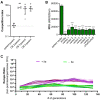Prolonging genetic circuit stability through adaptive evolution of overlapping genes
- PMID: 37260076
- PMCID: PMC10359631
- DOI: 10.1093/nar/gkad484
Prolonging genetic circuit stability through adaptive evolution of overlapping genes
Abstract
The development of synthetic biological circuits that maintain functionality over application-relevant time scales remains a significant challenge. Here, we employed synthetic overlapping sequences in which one gene is encoded or 'entangled' entirely within an alternative reading frame of another gene. In this design, the toxin-encoding relE was entangled within ilvA, which encodes threonine deaminase, an enzyme essential for isoleucine biosynthesis. A functional entanglement construct was obtained upon modification of the ribosome-binding site of the internal relE gene. Using this optimized design, we found that the selection pressure to maintain functional IlvA stabilized the production of burdensome RelE for >130 generations, which compares favorably with the most stable kill-switch circuits developed to date. This stabilizing effect was achieved through a complete alteration of the allowable landscape of mutations such that mutations inactivating the entangled genes were disfavored. Instead, the majority of lineages accumulated mutations within the regulatory region of ilvA. By reducing baseline relE expression, these more 'benign' mutations lowered circuit burden, which suppressed the accumulation of relE-inactivating mutations, thereby prolonging kill-switch function. Overall, this work demonstrates the utility of sequence entanglement paired with an adaptive laboratory evolution campaign to increase the evolutionary stability of burdensome synthetic circuits.
© The Author(s) 2023. Published by Oxford University Press on behalf of Nucleic Acids Research.
Figures







Similar articles
-
Engineering gene overlaps to sustain genetic constructs in vivo.PLoS Comput Biol. 2021 Oct 8;17(10):e1009475. doi: 10.1371/journal.pcbi.1009475. eCollection 2021 Oct. PLoS Comput Biol. 2021. PMID: 34624014 Free PMC article.
-
An efficient approach to identify ilvA mutations reveals an amino-terminal catalytic domain in biosynthetic threonine deaminase from Escherichia coli.J Bacteriol. 1993 Oct;175(20):6605-13. doi: 10.1128/jb.175.20.6605-6613.1993. J Bacteriol. 1993. PMID: 8407838 Free PMC article.
-
Visualization of evolutionary stability dynamics and competitive fitness of Escherichia coli engineered with randomized multigene circuits.ACS Synth Biol. 2013 Sep 20;2(9):519-28. doi: 10.1021/sb400055h. Epub 2013 Sep 4. ACS Synth Biol. 2013. PMID: 24004180
-
Optimizing scaleup yield for protein production: Computationally Optimized DNA Assembly (CODA) and Translation Engineering.Biotechnol Annu Rev. 2007;13:27-42. doi: 10.1016/S1387-2656(07)13002-7. Biotechnol Annu Rev. 2007. PMID: 17875472 Review.
-
Addressing biological uncertainties in engineering gene circuits.Integr Biol (Camb). 2016 Apr 18;8(4):456-64. doi: 10.1039/c5ib00275c. Epub 2015 Dec 17. Integr Biol (Camb). 2016. PMID: 26674800 Free PMC article. Review.
Cited by
-
A synthetic differentiation circuit in Escherichia coli for suppressing mutant takeover.Cell. 2024 Feb 15;187(4):931-944.e12. doi: 10.1016/j.cell.2024.01.024. Epub 2024 Feb 5. Cell. 2024. PMID: 38320549 Free PMC article.
-
Toxin-Antitoxin Systems Reflect Community Interactions Through Horizontal Gene Transfer.Mol Biol Evol. 2024 Oct 4;41(10):msae206. doi: 10.1093/molbev/msae206. Mol Biol Evol. 2024. PMID: 39404847 Free PMC article.
-
Degradation of polyethylene terephthalate (PET) plastics by wastewater bacteria engineered via conjugation.Microb Biotechnol. 2024 Sep;17(9):e70015. doi: 10.1111/1751-7915.70015. Microb Biotechnol. 2024. PMID: 39315602 Free PMC article.
-
GENTANGLE: integrated computational design of gene entanglements.Bioinformatics. 2024 Jul 1;40(7):btae380. doi: 10.1093/bioinformatics/btae380. Bioinformatics. 2024. PMID: 38905502 Free PMC article.
-
The design and engineering of synthetic genomes.Nat Rev Genet. 2025 May;26(5):298-319. doi: 10.1038/s41576-024-00786-y. Epub 2024 Nov 6. Nat Rev Genet. 2025. PMID: 39506144 Review.
References
-
- Puurunen M.K., Vockley J., Searle S.L., Sacharow S.J., Phillips J.A., Denney W.S., Goodlett B.D., Wagner D.A., Blankstein L., Castillo M.J.et al. .. Safety and pharmacodynamics of an engineered E. coli Nissle for the treatment of phenylketonuria: a first-in-human phase 1/2a study. Nat. Metab. 2021; 3:1125–1132. - PubMed
-
- Steidler L., Hans W., Schotte L., Neirynck S., Obermeier F., Falk W., Fiers W., Remaut E.. Treatment of murine colitis by Lactococcus lactis secreting interleukin-10. Science. 2000; 289:1352–1355. - PubMed
Publication types
MeSH terms
LinkOut - more resources
Full Text Sources
Research Materials

